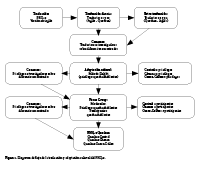Cultural adaptation to Quechua and psychometric analysis of the Patient Health Questionnaire PHQ-9 in a peruvian population
DOI:
https://doi.org/10.17843/rpmesp.2023.403.12571Keywords:
Patient Health Questionnaire, depression, Indigenous Peoples, PsychometricsAbstract
Objective. To translate and culturally adapt the Patient Health Questionnaire (PHQ-9) to three varieties of Quechua and analyse their validity, reliability, and measurement invariance. Materials and methods. 1) Cultural adaptation phase: the PHQ-9 was translated from English into three variants of Quechua (Central, Chanca, Cuzco-Collao) and translated again into English. Then, experts and focus groups allowed the translations to be culturally adapted. 2) Psychometric phase: the unidimensionality of the adapted PHQ-9 was evaluated by using Confirmatory Factor Analysis (CFA), reliability was evaluated by internal consistency (Alpha and Omega), and measurement invariance according to Quechua varieties and sociodemographic variables was evaluated by using CFA, multigroups and MIMIC models (Multiple Indicator Multiple Cause). Results. Each of the adaptations of the PHQ-9 to the three Quechua varieties reported clear and culturally equivalent items. Subsequently, data from 970 Quechua-
speaking adult men and women were analyzed. The general one-dimensional model reported an adequate fit (Comparative fit index = 0.990, Tucker-Lewis index = 0.987, Standardized root mean squared residual= 0.048, Root mean squared error of approximation= 0.071); each of the Quechua varieties also showed an adequate fit. Reliability was high for all varieties (α = 0.865 - 0.915; ω = 0.833 - 0.881). The results of the multigroup CFA and MIMIC models confirmed measurement invariance according to Quechua variant, sex, residence, age, marital status and educational level. Conclusions. The PHQ-9 adaptations to Central Quechua, Chanca and Cuzco-Collao offer a valid, reliable and invariant measurement, confirming that comparisons can be
made between the evaluated groups. Its use will benefit mental health research and care for Quechua-speaking populations.
Downloads
References
Villarreal-Zegarra D, Copez-Lonzoy A, Bernabé-Ortiz A, Melendez-Torres GJ, Bazo-Alvarez JC. Valid group comparisons can be made with the Patient Health Questionnaire (PHQ-9): A measurement invariance study across groups by demographic characteristics. PLOS ONE. 2019;14(9):e0221717. doi: 10.1371/journal.pone.0221717.
World Health Organization. WHO. 2021 [citado el 5 de julio de 2022]. Depression. Disponible en: https://www.who.int/health-topics/depression.
World Health Organization. WHO. 2022 [citado el 5 de julio de 2022]. COVID-19 pandemic triggers 25% increase in prevalence of anxiety and depression worldwide. Disponible en: https://www.who.int/news/item/02-03-2022-covid-19-pandemic-triggers-25-increase-inprevalence-of-anxiety-and-depression-worldwide.
Antiporta DA, Cutipé YL, Mendoza M, Celentano DD, Stuart EA, Bruni A. Depressive symptoms among Peruvian adult residents amidst a National Lockdown during the COVID-19 pandemic. BMC Psychiatry. 2021;21(1):111. doi: 10.1186/s12888-021-03107-3.
Hernández-Vásquez A, Vargas-Fernández R, Bendezu-Quispe G, Grendas LN. Depression in the Peruvian population and its associated factors: analysis of a national health survey. Journal of Affective Disorders. 2020;273(1):291–7. doi: 10.1016/j.jad.2020.03.100.
American Psychiatric Association. The Diagnostic and Statistical Manual of Mental Disorders, Fouth Edition,Text Revision (DSM-4) [Internet]. 2013 [citado el 13 de julio de 2022]. Disponible en: https://psychiatry.org:443/psychiatrists/practice/dsm
Kroenke K, Spitzer RL, Williams JBW. The PHQ-9 Validity of a Brief Depression Severity Measure. Journal of General Internal Medicine. 2001;16(9):606–13. doi: https://doi.org/10.1046/j.1525-1497.2001.016009606.x.
Obbarius A, van Maasakkers L, Baer L, Clark DM, Crocker AG, de Beurs E, et al. Standardization of health outcomes assessment for depression and anxiety: recommendations from the ICHOM Depression and Anxiety Working Group. Qual Life Res. 2017;26(12):3211–25. doi: 10.1007/s11136-017-1659-5.
El-Den S, Chen TF, Gan YL, Wong E, O’Reilly CL. The psychometric properties of depression screening tools in primary healthcare settings: A systematic review. Journal of Affective Disorders. 2018;225(1):503–22. doi: 10.1016/j.jad.2017.08.060.
Arthurs E, Steele RJ, Hudson M, Baron M, Thombs BD, Group (CSRG) Canadian Scleroderma Research. Are Scores on English and French Versions of the PHQ-9 Comparable? An Assessment of Differential Item Functioning. PLOS ONE. 2012;7(12):e52028. doi: 10.1371/journal.pone.0052028.
Leung D, Wah Y, Leung SF, Chiang V, Yuen A. Measurement invariances of the PHQ‐9 across gender and age groups in Chinese adolescents. Asia-Pacific Psychiatry. 2020;12(e12381). doi: https://doi.org/10.1111/appy.12381.
Muñoz-Navarro R, Cano-Vindel A, Medrano LA, Schmitz F, Ruiz-Rodríguez P, Abellán-Maeso C, et al. Utility of the PHQ-9 to identify major depressive disorder in adult patients in Spanish primary care centres. BMC Psychiatry. 2017;17(1):291. doi: 10.1186/s12888-017-1450-8.
Pogosova NV, Dovzhenko TV, Babin AG, Kursakov AA, Vygodin VA. Russian version of PHQ-2and 9 questionnaires: Sensitivity and specificity in detection of depression in outpatient general medical practice. Cardiovascular Therapy and Prevention. 2014;13(3):18–24. Disponible en: https://cardiovascular.elpub.ru/jour/article/view/51.
Reich H, Rief W, Brähler E, Mewes R. Cross-cultural validation of the German and Turkish versions of the PHQ-9: an IRT approach. BMC Psychology. 2018;6(1):26. doi: 10.1186/s40359-018-0238-z.
Wisting L, Johnson SU, Bulik CM, Andreassen OA, Rø Ø, Bang L. Psychometric properties of the Norwegian version of the Patient Health Questionnaire-9 (PHQ-9) in a large female sample of adults with and without eating disorders. BMC Psychiatry. 2021;21(1):6. doi: 10.1186/s12888-020-03013-0.
Maroufizadeh S, Omani-Samani R, Almasi-Hashiani A, Amini P, Sepidarkish M. The reliability and validity of the Patient Health Questionnaire-9 (PHQ-9) and PHQ-2 in patients with infertility. Reproductive Health. 2019;137(16):e. doi: https://doi.org/10.1186/s12978-019-0802-x.
Pranckeviciene A, Saudargienne A, Gecaite-Stonciene J, Liaugaudaite V, Griskova-Bulanova I, Simkute D, et al. Validation of the patient health questionnaire-9 and the generalized anxiety disorder-7 in Lithuanian student sample. Plos One. 2022;27(1):e0263027. doi: 10.1371/journal.pone.0263027.
Sebera F, Nickenig JR, Umwiringirwa J, Teuwen D, Boon P, Dedeken P. Validity, reliability and cut-offs of the Patient Health Questionnaire-9 as a screening tool for depression among patients living with epilepsy in Rwanda. Plos One. 2020 ;12(6):e0234095. doi: 10.1371/journal.pone.0234095.
Baas KD, Cramer AOJ, Koeter MWJ, van de Lisdonk EH, van Weert HC, Schene AH. Measurement invariance with respect to ethnicity of the Patient Health Questionnaire-9 (PHQ-9). Journal of Affective Disorders. 2011;129(1):229–35. doi: doi.org/10.1016/j.jad.2010.08.026.
Putnick DL, Bornstein MH. Measurement Invariance Conventions and Reporting: The State of the Art and Future Directions for Psychological Research. Dev Rev. 2016;41:71–90. doi: 10.1016/j.dr.2016.06.004.
Andrade L. Diez noticias sobre el quechua en el último censo peruano. Letras (Lima). 2019;90(132):41–70. doi: 10.30920/letras.90.132.2.
Luykx A, Rivera FG, Julca F. Communicative strategies across Quechua languages. International Journal of the Sociology of Language. 2016 ;2016(240):159–91. doi: 10.1515/ijsl-2016-0018.
Julca F. Quechua ancashino. Una mirada actual. Lexis. 2011;35(2):430. Disponible en: https://repositorio.pucp.edu.pe/index/handle/123456789/183128.
Cerrón-Palomino R. Lingüística quechua. Vol. 2. Centro de Estudios Rurales Andinos “Bartolomé de las Casas”; 1987. 434 p. Disponible en: https://cbc.org.pe/producto/linguistica-quechua-2/.
American Educational Research Association, American Psychological Association, National Council on Measurement in Education. Estándares para Pruebas Educativas y Psicológicas [Internet]. 2nd ed. Estados Unidos: American Educational Research Association; 2018. Disponible en: https://www.testingstandards.net/uploads/7/6/6/4/76643089/spanish_standards_pdf.pdf.
Montesinos-Segura R, Maticorena-Quevedo J, Chung-Delgado K, Pereyra-Elías R, Taype-Rondan A, Mayta-Tristán P. Place of origin associated with depressive symptoms in health professionals performing social health service in Ancash, Peru, 2015. Rural Remote Health. 2018;18(2):4331. doi: 10.22605/RRH4331.
Hambleton R, Merenda M, Spielberger C. Adapting Educational and Psychological Tests for Cross-Cultural Assessment [Internet]. Vol. 1. Psychology Press; 2005 [citado el 21 de mayo de 2021]. Disponible en: https://www.routledge.com/Adapting-Educational-and-Psychological-Tests-for-Cross-Cultural-Assessment/Hambleton-Merenda-Spielberger/p/book/9780805861761.
Instituto Nacional de Estadística e Informática. Perú: Perfil sociodemográfico Informe nacional - Censos nacionales 2017: XII de Población, VII de Vivienda y III de Comunidades Indígenas [Internet]. Lima: INEI; 2018. Disponible en: https://www.inei.gob.pe/media/MenuRecursivo/publicaciones_digitales/Est/Lib1539/libro.pdf.
Kyriazos TA. Applied Psychometrics: Sample Size and Sample Power Considerations in Factor Analysis (EFA, CFA) and SEM in General. Psychology. 2018;09(08):2207. doi: 10.4236/psych.2018.98126.
Widaman KF, Reise SP. Exploring the measurement invariance of psychological instruments: Applications in the substance use domain. En: The science of prevention: Methodological advances from alcohol and substance abuse research. Washington, DC, US: American Psychological Association; 1997. p. 281–324.
Brauer K, Ranger J, Ziegler M. Confirmatory Factor Analyses in Psychological Test Adaptation and Development. Psychological Test Adaptation and Development. 2023;4(1):4–12. doi: 10.1027/2698-1866/a000034.
Cheung GW, Rensvold RB. Evaluating Goodness-of-Fit Indexes for Testing Measurement Invariance. Structural Equation Modeling: A Multidisciplinary Journal. 2002 ;9(2):233–55. doi: https://doi.org/10.1207/S15328007SEM0902_5.
Yoon M, Lai MHC. Testing Factorial Invariance With Unbalanced Samples. Structural Equation Modeling: A Multidisciplinary Journal. 2018 ;25(2):201–13. doi: 10.1080/10705511.2017.1387859.
Domínguez-Lara SA, Merino-Soto C. ¿Por qué es importante reportar los intervalos de confianza del coeficiente alfa de Cronbach? Revista Latinoamericana de Ciencias Sociales, Niñez y Juventud [Internet]. 2015;13(2):4. Disponible en: https://www.redalyc.org/pdf/773/77340728053.pdf.
McDonald R. Test Theory : A Unified Treatment [Internet]. Psychology Press; 1999 [citado el 1 de julio de 2022]. Disponible en: https://www.taylorfrancis.com/books/mono/10.4324/9781410601087/test-theory-roderick-mcdonald.
Rosseel Y. lavaan: An R Package for Structural Equation Modeling. Journal of Statistical Software [Internet]. 2012 [citado el 1 de julio de 2022];48(2):1–36. Disponible en: https://www.jstatsoft.org/article/view/v048i02.
Oberski D. lavaan.survey: An R Package for Complex Survey Analysis of Structural Equation Models. Journal of Statistical Software. 2014 ;57:1–27. doi:10.18637/jss.v057.i01.
Terrence DJ. Useful Tools for Structural Equation Modeling [Internet]. 2022. Disponible en: https://cran.r-project.org/web/packages/semTools/semTools.pdf.
Epskamp S. semPlot: Unified Visualizations of Structural Equation Models. Structural Equation Modeling: A Multidisciplinary Journal. 2015 ;22(3):474–83. doi:10.1080/10705511.2014.937847.
Komperda R. Likert-Type Survey Data Analysis with R and RStudio. En: Computer-Aided Data Analysis in Chemical Education Research (CADACER): Advances and Avenues. American Chemical Society; 2017. p. 91–116. (ACS Symposium Series; vol. 1260). doi: 10.1021/bk-2017-1260.ch007.
Cjuno J, Figueroa-Quiñones J, Marca-Dueñas GG, Esteban RFC. Producción científica sobre depresión en poblaciones quechua hablantes: una revisión narrativa. Terapia Psicológica. 2021 ;163–74. doi: 10.4067/s0718-48082021000200163.
Tremblay J, Pedersen D, Errazuriz C. Assessing Mental Health Outcomes of Political Violence and Civil Unrest in Peru. Int J Soc Psychiatry. 2009 ;55(5):449–63. doi: 10.1177/0020764009103214.
Lamela D, Soreira C, Matos P, Morais A. Systematic review of the factor structure and measurement invariance of the Patient Health Questionnaire-9 (PHQ-9) and validation of the Portuguese version in community settings. Journal of Affective Disorders. 2020;276:220–33. doi: 10.1016/j.jad.2020.06.066.
Negeri ZF, Levis B, Sun Y, He C, Krishnan A, Wu Y, et al. Accuracy of the Patient Health Questionnaire-9 for screening to detect major depression: updated systematic review and individual participant data meta-analysis. BMJ. 2021;375:n2183. doi: 10.1136/bmj.n2183.
Saldivia S, Aslan J, Cova F, Vicente B, Inostroza C, Rincón P, et al. Propiedades psicométricas del PHQ-9 (Patient Health Questionnaire) en centros de atención primaria de Chile. Revista médica de Chile. 2019;147(1):53–60. doi: 10.4067/S0034-98872019000100053.
Mwangi P, Nyongesa M, Koot H, Cuijpers P, Newton C, Abubakar A. Validation of a Swahili version of the 9-item Patient Health Questionnaire (PHQ-9) among adults living with HIV compared to a community sample from Kilifi, Kenya. Journal of Affective Disorders Reports. 2020 ;1. doi: 10.1016/j.jadr.2020.100013.
Merz EL, Malcarne VL, Roesch SC, Riley N, Sadler GR. A Multigroup Confirmatory Factor Analysis of the Patient Health Questionnaire-9 among English- and Spanish-speaking Latinas. Cultur Divers Ethnic Minor Psychol. 2011;17(3):309–16. doi: 10.1037/a0023883.
Keum BT, Miller MJ, Inkelas KK. Testing the factor structure and measurement invariance of the PHQ-9 across racially diverse U.S. college students. Psychological Assessment. 2018;30(8):1096–106. doi: 10.1037/pas0000550.

Downloads
Published
Issue
Section
License
Copyright (c) 2023 Julio Cjuno, Félix Julca-Guerrero, Yulisa Oruro-Zuloaga, Frinee Cruz-Mendoza, Admirson Auccatoma-Quispe, Heber Gómez Hurtado, Frank Peralta-Alvarez, Juan Carlos Bazo-Alvarez

This work is licensed under a Creative Commons Attribution 4.0 International License.




























